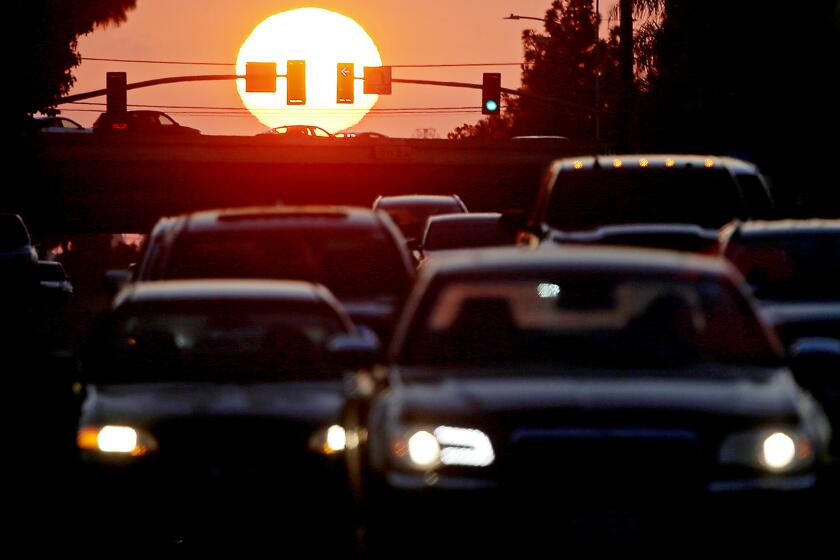California loses population for an unprecedented third year. It could cost state real clout

- Share via
For the third year in a row, California saw its population drop, raising new concerns about how the much-discussed exodus could hurt the state’s political influence.
The state’s population declined by around 37,000 people from July 1, 2022, to July 1, 2023, or 0.1%. The loss is minuscule compared with the more than 500,000 people the state lost from April 2020 to July 2022. But it still represents the sixth-largest rate of loss of any state during that time span.
Prior to the fiscal year from July 1, 2020, to July 1, 2021, California had never seen even one year of population decline since 1900, according to U.S. Census Bureau data.
The numbers suggest California’s latest exodus is slowing as the pandemic eases, but it still remains a concern.
Only New York, Louisiana, Hawaii, Illinois and West Virginia lost a larger share of their population over the year.
California remains the nation’s most populous state by far (39.1 million), but since April 2020, its population has dropped by a total of 1.5% — the fourth-most of any state. Idaho, South Carolina and Florida have gained the most people in this period, each experiencing growth of 5% or more.
The Golden State added about 107,000 people by natural increase — the difference between births and deaths — between July 1, 2022, and July 1, 2023, according to the Census data.
Additionally, foreign immigration recovered to pre-pandemic levels, with a net gain of more than 115,000 people. Immigration had been of concern to demographers as the state and country recorded plummeting immigration levels earlier in the pandemic.
Net domestic out-migration continued, as 260,000 more people left California for other states than moved into California from elsewhere. This number was lower than in the previous two years, when 360,000 and 295,000 more people left than arrived, respectively.
The population dip has generated much attention — too much, according to some state boosters. The reasons for it vary, including remote work options made possible during the pandemic as well California’s high housing costs, particularly in coastal regions. California’s urban areas are still reeling as places such as downtown Los Angeles and San Francisco struggle with far fewer office workers.
And with these demographic changes, California risks losing its national clout, with less federal funding, an aging workforce and even diminished political power.
Commute times decreased during the pandemic after rising for years before. As Southern California sprawls, long commutes seem to be inevitable.
An analysis from the Brennan Center for Justice projected that congressional redistricting in 2030 would leave California with just 48 seats in the House of Representatives, down from the current total of 52 members. It would be the second time ever that the state would lose representation in the House, with nearly 10% of its former 53-member delegation gone since 2021.
But there are caveats.
The analysis assumes that the state will continue to lose residents as it did over the last year, though many experts believe California’s pandemic-induced population loss will ultimately rebound.
Projecting 2030 population based on a one-year change “would be like taking the first 4.8 minutes of a basketball game” with a 7-0 score and projecting a 70-0 final score, said Paul Mitchell, one of the state’s foremost political data analysts.
About 60,000 more people moved from California to Texas than the other way in 2022. Experts point to housing, taxes and politics.
He believes that the state will lose House seats, as it did in the most recent redistricting, but that “50 is probably a good number.”
“There’s a reality of the impacts of a lower census count ... in terms of the amount of money we’re getting from federal dollars and the political representation,” he said.
In addition to losing overall power and influence in the federal government, the relative power of parts of the state will shift as the population realigns, Mitchell projects.
“Places like the Inland Empire are not losing population as fast as places like L.A. County” or the Bay Area, he said, suggesting that funding and political power — including the state’s congressional representation — may shift toward the Inland Empire and Central Valley and away from cities.
The California counties that lost the most people were in rural Northern California areas including Lassen, Plumas and Glenn counties, which all had a population drop of more than 1% over the last year.

Subscribers get exclusive access to this story
We’re offering L.A. Times subscribers special access to our best journalism. Thank you for your support.
Explore more Subscriber Exclusive content.
Los Angeles County’s population continued to drop in the 12 months ending July 1, 2023, though the losses slowed to 0.15%; while San Francisco County’s decline rebounded somewhat with 0.58% growth. No California counties saw growth of more than 0.76%.
“If L.A. is losing seats, then that does potentially impact Democrats more,” Mitchell said, noting that Democratic-leaning parts of the state are losing people faster than more conservative areas.
The picture is complicated, he acknowledged, because some of the people moving to suburbs and exurbs are former city-dwellers, who could bring liberal politics with them.
More to Read
Sign up for This Evening's Big Stories
Catch up on the day with the 7 biggest L.A. Times stories in your inbox every weekday evening.
You may occasionally receive promotional content from the Los Angeles Times.













